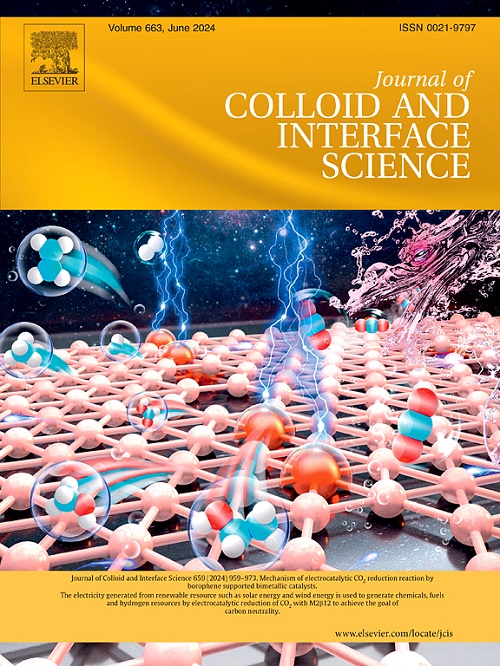Engineering metal-oxide interfaces via controlled exsolution in Ir-doped Y2Ru2O7 pyrochlore for superior hydrogen evolution reaction
IF 9.4
1区 化学
Q1 CHEMISTRY, PHYSICAL
引用次数: 0
Abstract
Developing efficient and durable electrocatalysts for hydrogen evolution reaction (HER) is crucial for advancing sustainable energy technologies. Pyrochlore oxides show promise due to their structural versatility, but their application in HER is limited by weak hydrogen binding, poor conductivity, and insufficient active site exposure. Here, we demonstrate a controlled in-situ exsolution approach to create optimized RuIr/Y2O3 heterointerfaces from Ir-doped Y2Ru2O7 pyrochlore oxide. Through systematic tuning of reduction parameters, we achieve precise control over size and distribution of exsolved RuIr nanoparticles, forming intimate metal-oxide heterojunctions with enhanced charge transfer properties. The optimized YRIO-450-8H (Y2Ru1.7Ir0.3O7 reduced at 450 °C for 8 h) catalyst exhibits exceptional HER performance, requiring only 20 and 30 mV overpotential to deliver 10 mA cm−2 in alkaline and acidic media, respectively, outperforming commercial Pt/C. Mechanistic investigations combining advanced characterizations and DFT calculations reveal that the remarkable activity stems from synergistic effects: (1) optimized hydrogen binding energy (−0.13 eV) at RuIr sites, (2) electronic structure modulation at the metal-oxide interface, and (3) abundant oxygen vacancies facilitating water dissociation. The catalyst maintains activity over 120 h in alkaline and 55 h in acidic conditions, providing fundamental insights into exsolution mechanisms and design principles for high-performance heterogeneous electrocatalysts.

通过在掺铁的Y2Ru2O7焦绿石中控制析出来设计金属-氧化物界面,以获得更好的析氢反应
开发高效、耐用的析氢电催化剂是推进可持续能源技术的关键。焦绿石氧化物由于其结构的通用性而显示出前景,但其在HER中的应用受到氢结合弱、导电性差和活性位点暴露不足的限制。在这里,我们展示了一种受控的原位析出方法,以ir掺杂的Y2Ru2O7焦绿盐氧化物为原料,创建优化的RuIr/Y2O3异质界面。通过系统调整还原参数,我们实现了对RuIr纳米颗粒尺寸和分布的精确控制,形成了具有增强电荷转移特性的亲密金属氧化物异质结。优化后的yio -450- 8h (y2ru1.7 ir0.37在450°C下还原8 h)催化剂表现出优异的HER性能,在碱性和酸性介质中分别只需要20和30 mV过电位就能输送10 mA cm - 2,优于商用Pt/C。结合先进表征和DFT计算的机制研究表明,显著的活性源于协同效应:(1)RuIr位点的氢结合能优化(- 0.13 eV),(2)金属-氧化物界面的电子结构调制,(3)丰富的氧空位促进水解离。该催化剂在碱性条件下可保持120 h以上的活性,在酸性条件下可保持55 h以上的活性,为高性能非均相电催化剂的溶出机理和设计原则提供了基本的见解。
本文章由计算机程序翻译,如有差异,请以英文原文为准。
求助全文
约1分钟内获得全文
求助全文
来源期刊
CiteScore
16.10
自引率
7.10%
发文量
2568
审稿时长
2 months
期刊介绍:
The Journal of Colloid and Interface Science publishes original research findings on the fundamental principles of colloid and interface science, as well as innovative applications in various fields. The criteria for publication include impact, quality, novelty, and originality.
Emphasis:
The journal emphasizes fundamental scientific innovation within the following categories:
A.Colloidal Materials and Nanomaterials
B.Soft Colloidal and Self-Assembly Systems
C.Adsorption, Catalysis, and Electrochemistry
D.Interfacial Processes, Capillarity, and Wetting
E.Biomaterials and Nanomedicine
F.Energy Conversion and Storage, and Environmental Technologies

 求助内容:
求助内容: 应助结果提醒方式:
应助结果提醒方式:


